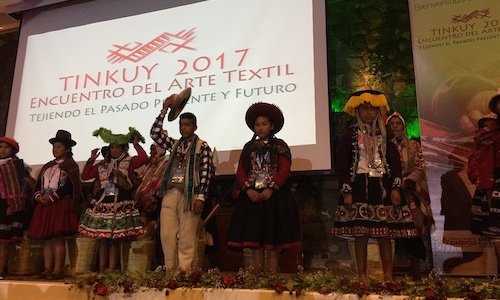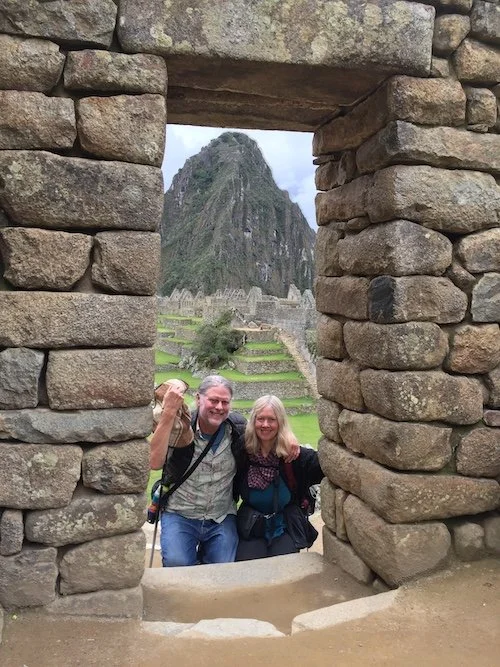Off to Peru, 2017
Several months after teaching doubleweave at the 2013 Tinkuy conference I was contacted by Marilyn Murphy and asked if we could chat on the phone so that she could interview me about my experience and write an article for the Andean Textile Arts newsletter. I described in detail my process in preparing for the workshop, as well as how everything went in the class itself. I told her that it was one of the highlights of my life and that I hoped I could be more involved in working with the weavers in Peru. She said, “Oh, you don’t have a choice.”
Sure enough, a few months later she called me again and told me that the ATA board wanted to invite me to become a member, and would I also be willing to serve as treasurer? I had a reasonable amount of bookkeeping experience under my belt, having taken care of the financial end of my former husband’s company and a gallery in Santa Fe. And I felt honored and pretty thrilled to be brought into the nonprofit organization and be able to support their cause in a deeper way.
I was officially brought into the board at the annual meeting in March of 2015. A significant topic of discussion was the plans for the next Tinkuy conference to be held in Cusco in November 2017. My job as treasurer ramped up as I processed payments for every registrant, as well as for everyone who signed up for the two ATA tours, one just prior to the conference and one just afterwards.
It was exciting for me to be involved at this level in the Tinkuy, and to feel that I was really a part of the family now. What I was especially excited about was plans for a pair of exhibits of textiles that had been woven in doubleweave pickup since the 2013 workshop. My partner, Nelson, decided to go to the conference with me, and since he had never been to Peru, we decided to visit the same places that I had been to on my two previous trips.
We arrived in Cusco four days before the conference was scheduled to begin for two reasons. One was that I love the city of Cusco and had never gotten as much time as I wanted to explore there on my previous trips. It feels very comfortable and enchanting to me because it has a very similar character to Santa Fe on a larger scale, and there are beautiful textiles everywhere you look. The second reason we wanted to arrive early was so that we could help mount the doubleweave textiles and install the two exhibits.
I was amazed to see how far the weavers had come with doubleweave in the four years that had passed since the last Tinkuy, and how much they had made it their own. I was particularly pleased to find that none of the textiles in the exhibits had been woven by students in my workshop. That meant that the goal of having the original students teach other weavers in their community had met with success.
The Quechua weavers clearly didn’t feel limited in any way to working in just a single pair of light and dark colors. And in addition to using geometric and animal motifs that are traditional in their culture, they added in all kinds of elements and stories from their daily lives. I was fascinated by this textile that was woven by Susana Huaman Huanca from Pitumarca.
There is an amazing variety and creativity to the people and animals in this piece, and I love the way that design elements carry over from one color band to the next. Even the wave design around the border is a separately woven doubleweave pickup band. I was able to purchase and bring this piece home with me, and it is now one of my treasures.
Then it was time for the conference to begin. Again it started with a parade through the center of Cusco with music and dancing leading us to the conference center. Most of the members of the Andean Textile Arts board had come to the conference, and we proudly held up our banner to greet people as they entered the courtyard.
As with the previous two Tinkuys, there were wonderful lectures and discussions. This time there were over 700 people attending the conference from all over the world, and we learned about projects that are taking place in India and Afghanistan, among others. Evenings were again filled with colorful dances from various communities, drop spindle spinning lessons and a spectacular fashion show on the last evening.
Nelson and I headed off on our own private tour of the Sacred Valley the next day, but began by joining the larger group in Chinchero for another day of natural dyeing. A special event that afternoon was the grand opening of a replication of a traditional Quechua home. Walking through it from room to room you can see how a typical family may have lived there until as recently as the 1960’s.
Even though this was my third trip to Peru visiting the same locations each time, I saw it through fresh eyes as I introduced Nelson to each place and we created our own memories. It was easy for him to see why Peru holds a special place in my heart and why I hope to return there again and again.







